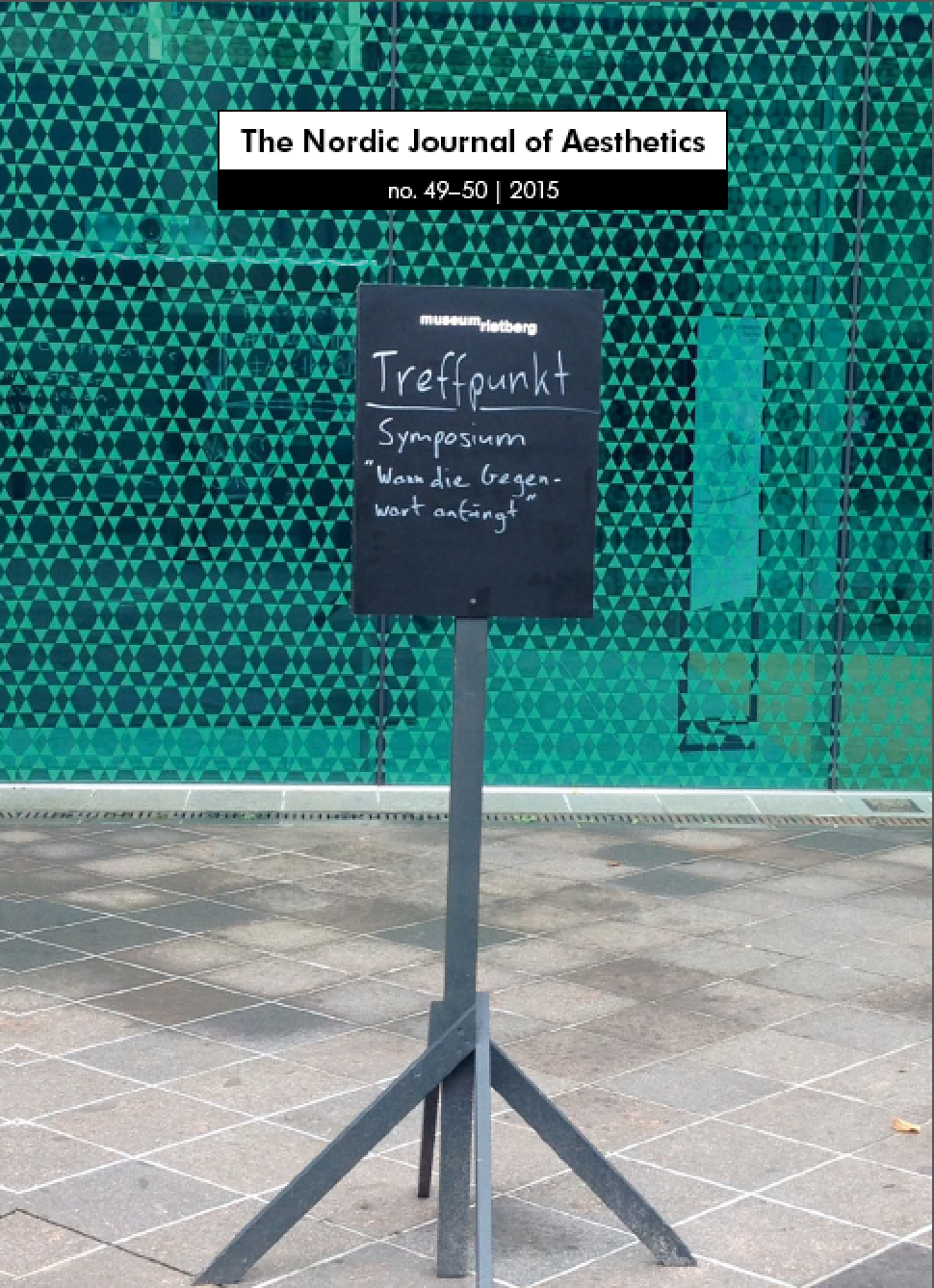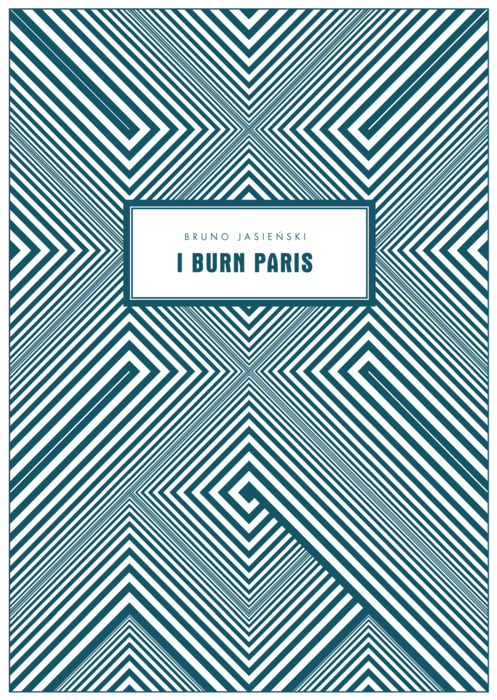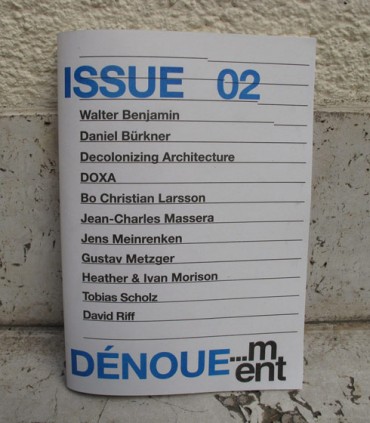Nordic Journal of Aesthetics, 49-50: Art, Remembrance and History (2015)
Filed under journal | Tags: · art criticism, art history, catastrophe, contemporaneity, history, theory

“This issue of The Nordic Journal of Aesthetics addresses the question of art’s ability to give form to the catastrophic events of the 20th century, primarily World War II and the atomic bomb, but on the way it – necessarily – broadens the scope of the enquiry to include the question of the relationship between art, remembrance and history today. The articles all contribute to the discussion of that complex relationship asking how art can call attention to past and present historical events of a catastrophic character with a view to changing the present (and the past). History – as Walter Benjamin has taught us – is always written from the present and ‘official history’ thus always has a very selective framing of the victims of history preferring to exclude and ‘invisibilize’ certain subjects and groups in order to naturalize the present order.”
Essays by Gene Ray, Sven Lütticken, Gavin Grindon, Mikkel Bolt Rasmussen, Ernst Van Alpen, Jacob Lund, Terry Smith, and Peter Osborne.
Edited by Mikkel Bolt and Jacob Lund
Publisher Thales, Stockholm, 2015
ISSN 2000-9607
188 pages
Bruno Jasieński: I Burn Paris (1928–) [PL, EN, ES]
Filed under fiction | Tags: · avant-garde, catastrophe, communism, futurism, marxism

I Burn Paris has remained one of Poland’s most uncomfortable masterstrokes of literature since its initial and controversial serialization by Henri Barbusse in 1928 in L’Humanité (for which Jasieński was deported for disseminating subversive literature). It tells the story of a disgruntled factory worker who, finding himself on the streets, takes the opportunity to poison Paris’s water supply. With the deaths piling up, we encounter Chinese communists, rabbis, disillusioned scientists, embittered Russian émigrés, French communards and royalists, American millionaires and a host of others as the city sections off into ethnic enclaves and everyone plots their route of escape. At the heart of the cosmopolitan city is a deep-rooted xenophobia and hatred — the one thread that binds all these groups together. As Paris is brought to ruin, Jasienski issues a rallying cry to the downtrodden of the world, mixing strains of “The Internationale” with a broadcast of popular music.
With its montage strategies reminiscent of early avant-garde cinema and fist-to-the-gut metaphors, I Burn Paris has lost none of its vitality and vigor. Ruthlessly dissecting various utopian fantasies, Jasienski is out to disorient, and he has a seemingly limitless ability to transform the Parisian landscape into the product of disease-addled minds. An exquisite example of literary Futurism and Catastrophism, the novel presents a filthy, degenerated world where factories and machines have replaced the human and economic relationships have turned just about everyone into a prostitute. Yet rather than cliché and simplistic propaganda, there is an immediacy to the writing, and the modern metropolis is starkly depicted as only superficially cosmopolitan, as hostile and animalistic at its core.
This English translation of I Burn Paris fills a major gap in the availability of works from the interwar Polish avant-garde, an artistic phenomenon receiving growing attention with recent publications such as Caviar and Ashes.
First serialized in French as “Je brûle Paris” in L’Humanité in 1928.
Polish edition
Publisher Towarzystwo Wydawnicze “Rój”, Warsaw, 1929
English edition
Translated by Soren A. Gauger and Marcin Piekoszewski
With an Afterword by Soren Gauger
Publisher Twisted Spoon Press, Prague, 2012
ISBN 9788086264370
309 pages
Review (Benjamin Noys, Mute)
Review (M.A.Orthofer, The Complete Review)
Review (Isla Badenoch, Article Magazine)
Commentary (Nina Kolesnikoff, 1982)
Wikipedia (in Polish)
Publisher (EN)
Google books (EN)
Palę Paryż (Polish, 1929, HTML), Alt link
I Burn Paris (English, 2012, EPUB, removed on 2015-1-15 upon request of the publisher)
Anatol Stern’s 1957 preface (Polish), English translation (Issuu.com)
Voy a meterle fuego a París (Spanish, trans. Jorge Segovia and Violetta Beck, 2013, added on 2014-2-2)
…ment: Journal for Contemporary Culture, Art and Politics, 2: Dénouement (2011)
Filed under magazine | Tags: · art, capitalism, catastrophe, labour, politics

“From the financial crisis to natural and man-made disasters via the wave of political extremisms, our times are patterned with catastrophes of all kinds. While the contemporary meaning of catastrophe is commonly associated to the idea of disaster and collective trauma its origin mostly refers to a sudden turn, or a reversal of what is expected. Catastrophe would therefore be this shift that allows us to explore spaces that could not be accessed, whilst breaking with the existing or the normative. Issue 2 of …ment explores the dis-ordering nature of catastrophe whilst celebrating the potential of its narratives and imageries.
…ment is a journal for contemporary culture, art and politics published in irregular intervals. Through a multi-disciplinary set of editorial forms, the journal aims to reflect on current societal issues and debates.”
With contributions by Tobias Scholz, Jean-Charles Massera, David Riff, Daniel Bürkner, Jens Meinrenken, Walter Benjamin, Bo Christian Larsson, Heather & Ivan Morison, Gustav Metzger, DOXA. Also included in the journal is an excerpt Walter Benjamin’s Theses on Philosophy of History. The printed journal includes a special edition by Bo Christian Larsson.
Editor-in-chief: Federica Bueti
Associate editors: Benoit Loiseau, Clara Meister
98 pages
HTML (updated on 2020-10-19)
PDF (added on 2020-10-19)

